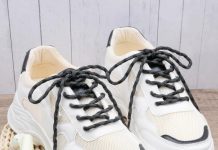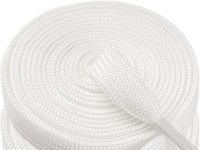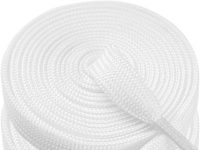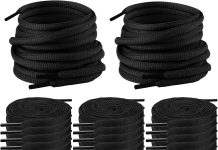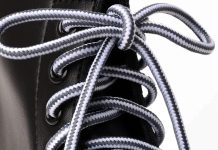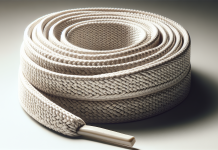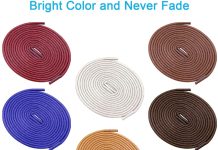?Have we ever stopped to think how much of a difference the right shoelace makes for our sneakers?
Product Overview
We looked closely at the “2 Pairs Shoelaces for Sneakers 8 mm Wide Flat Shoelace for Kids Adults Athletic Replacement Shoe Laces” to understand what it offers. This is a simple, budget-friendly pack aimed at replacing worn laces or giving our sneakers a quick refresh. The product name tells us the essentials: two pairs, flat construction, 8 mm width, and suitability for both kids and adults.
2 Pairs Shoelaces for Sneakers 8 mm Wide Flat Shoelace for Kids Adults Athletic Replacement Shoe Laces
Key Specifications
We want clarity at a glance, so we summarized the main specs below. These are the primary attributes to judge whether these laces will match our shoes and needs. We have included items that buyers typically care about when selecting replacement laces.
| Attribute | Details / Typical Options |
|---|---|
| Item | 2 pairs of flat shoelaces |
| Width | 8 mm (flat) |
| Length | Varies by listing (commonly 27–72 inches / 68–183 cm) — check the specific option before buying |
| Intended Use | Sneakers, athletic shoes, casual shoes for kids and adults |
| Material | Usually polyester or nylon (common for flat athletic laces) |
| Aglets | Typically molded plastic or reinforced tips |
| Color Options | Often available in multiple solid colors and sometimes patterns |
| Number of Pairs | 2 pairs per pack |
| Package Use | Replacement, spare, styling, DIY projects |
Design and Materials
We value design simplicity in a practical accessory like shoelaces, and these laces fit directly into that category. The flat design helps them sit neatly on the shoe without creating bulky overlaps, and the 8 mm width strikes a balance between slim and substantial. Regarding material, most of these laces on the market are made from synthetic fibers such as polyester or nylon, which offer a good mix of strength and stain resistance.
We should note that manufacturers sometimes vary in weave tightness and coating, which affects friction, knot-holding ability, and longevity. While the product listing doesn’t always state the exact fiber blend, the usual polyester construction is well-suited to athletic use and day-to-day wear.
Aglets and End Reinforcement
We think the aglets (the little tips at the ends) matter more than people expect because they determine how easily the lace threads through eyelets. Typical laces in this category use molded plastic aglets that are heat-sealed to prevent fraying. Some sellers may offer metal-capped aglets for a more premium look and extra durability, though that’s less common in basic two-pair packs.
The aglet style influences how often we need to redo our laces when they start to fray, and a sturdy aglet helps keep knotting predictable. If the listing specifies reinforced aglets, that’s a plus for frequent lacing and unlacing.
Sizing and Fit
Getting the right length is essential for function and aesthetics, so we always check length charts before ordering. Flat laces at 8 mm width are versatile and fill most eyelets without appearing too slim or too bulky. Common lengths available online range from short kid sizes to long laces for high-top or wide-lace designs. We recommend measuring our current laces or counting eyelets and using a size guide.
Here’s a short guide for lace lengths and typical shoe types to help choose:
| Shoe Type | Typical Recommended Lace Length |
|---|---|
| Low-top sneakers (4–5 eyelets) | 27–36 inches (68–91 cm) |
| Standard sneakers (5–6 eyelets) | 36–45 inches (91–114 cm) |
| Running shoes / athletic (6–7 eyelets) | 45–54 inches (114–137 cm) |
| High-tops / boots (8+ eyelets) | 54–72 inches (137–183 cm) |
We always remind ourselves to check the exact listing length because product names like this often have multiple length options. If the seller bundles lengths or leaves the length unspecified, contacting the seller first avoids surprises.
Width Considerations
The 8 mm width is a good middle ground for most sneakers. It provides stability in the eyelets and doesn’t slip as easily as very narrow round laces. For shoes with very tight eyelets or specific narrow channels, a slightly narrower lace might be better. Conversely, for a chunky aesthetic, we might prefer wider laces, but for functional athletic wear, 8 mm is typically ideal.
Performance and Durability
When we judge shoelace performance, we look at several factors: resistance to fraying, knot security, tensile strength, and how they react to moisture or sweat. Flat polyester laces usually score well on these criteria because the woven fibers resist abrasion and they retain shape after tightening.
In everyday use—tying, untying, and general movement—the laces should keep knots secure without loosening excessively. They should also resist superficial wear from rubbing against aglets and eyelets. If we plan to run or perform high-intensity activities, checking for reinforced weaving or denser construction is helpful because these will withstand repeated stress better.
How They Handle Moisture and Dirt
We’ve noticed that synthetic laces like polyester dry quickly and don’t absorb sweat like cotton, which reduces mildew risk and keeps odor at bay. Dirt and grime can cling to the weave but usually clean off with a gentle wash. A short handwash or a quick cycle in a mesh laundry bag should refresh the laces without damaging the aglets.
Comfort and Functionality
Comfort from shoelaces comes down to how they affect pressure distribution across the top of the foot and whether knots press into our feet during wear. Flat laces are generally more comfortable because they spread tension across a wider surface area than round laces. The 8 mm width contributes to comfortable pressure distribution, especially for longer wear or athletic use.
We also look at how easy the laces are to tighten and loosen. Flat laces usually offer a mix of friction and smoothness that allows a secure tie while still allowing quick adjustments when we’re on the go. That said, very slick laces (some coated synthetics) can sometimes slip; if knot security is crucial, we choose laces with a slightly grippy texture.
Kids and Adults: Versatility
The product explicitly mentions suitability for both kids and adults, which means the size range or the style is intended to be broadly usable. For kids, shorter lengths and bright colors help with independence and visibility. For adults, neutral or classic colors pair well with athletic and casual sneakers. We think the pack format (2 pairs) is practical because it gives us a spare or allows mixing colors for a custom look.
Style and Color Options
Shoelaces can be both functional and a quick way to change shoe aesthetics. The product name does not specify colorways, but packs like this often come in solid primary colors, neutrals (black, white, gray), and occasionally patterned options. We like having at least a couple of color choices—either to match our shoes exactly or to create contrast for a customized look.
Styling tips we use:
- Matching the lace to shoe accents creates a cohesive look.
- Contrasting bright laces on neutral shoes can make a casual outfit pop.
- Swapping laces between shoes instantly refreshes footwear without buying new sneakers.
Fashion Use Cases
We find that flat laces suit a range of shoe styles, from casual canvas sneakers to sporty running shoes. For fashion sneakers that rely on wider, visible laces, 8 mm may feel slightly thin compared to the oversized laces some fashion brands use. Still, for everyday athletic and casual wear, these laces strike a good aesthetic balance.
Installation and Lacing Techniques
Swapping out laces is straightforward, but we like to share a few lacing techniques that make the most of 8 mm flat laces. Each technique affects fit, comfort, and shoe appearance, so it’s worth trying a few to find what suits us.
Popular lacing methods to try:
- Criss-cross lacing: Classic and effective for most activities. It distributes pressure evenly and is easy to adjust.
- Straight bar lacing: Cleaner look for casual wear, reduces pressure points on the top of the foot.
- Lock lacing/heel lock: Great for runners who want to secure the heel and reduce slippage.
When installing, we thread the aglet through the bottom eyelets and ensure both lace ends are even before lacing up. If the aglet isn’t stiff enough, we sometimes add a small bit of clear tape temporarily to help feed through eyelets.
Tackling Stubborn Eyelets
Sometimes eyelets are narrow or rough, making lacing harder. We recommend:
- Smoothing any rough edges around the eyelet with a small file if practical.
- Using the aglet of a spare lace or a paperclip as a makeshift threading aid.
- Choosing slightly narrower laces if the shoe’s eyelets are especially constricted.
Care and Maintenance
To keep our laces looking fresh and functioning well, routine maintenance helps. Flat synthetic laces are low-maintenance compared to cotton, but they still pick up dirt and can fray over long-term use.
Cleaning tips:
- Hand wash with mild detergent and cold water; rinse thoroughly.
- Use a mesh laundry bag and a gentle machine cycle if we prefer machine washing.
- Air dry flat or hang to avoid heat damage that might warp aglets or melt synthetic fibers.
If a lace begins to fray near the aglet, a quick fix is to trim frayed threads and apply a small dab of clear nail polish or glue to seal the end. Replacing worn laces is easy due to the low cost, so we keep spares handy.
When to Replace
We replace laces when they:
- Show persistent fraying that affects threading.
- Have aglets that have popped off or crumbled.
- No longer hold knots securely despite retying.
Because this product includes two pairs, we often use one pair daily and keep the other pair as a ready replacement.
Comparing Similar Options
It helps to compare these flat 8 mm laces with other common types so we know where they fit in the broader market.
- Flat vs Round: Flat laces are more comfortable and secure under pressure; round laces can be slimmer and sometimes more decorative.
- Polyester vs Cotton: Polyester dries faster and resists stains, while cotton has a softer, more natural look but can absorb moisture.
- Standard vs Waxed: Waxed laces hold knots very well and resist dirt but can be stiffer; unwaxed flat polyester strikes a balance.
We recommend 8 mm flat polyester laces for everyday athletic use, casual sneakers, and situations where comfort and knot security matter.
Pros and Cons
We like to present a clear list of advantages and trade-offs so we can weigh whether this product fits our needs.
Pros:
- Practical flat design that distributes pressure comfortably.
- 8 mm width offers a stable, secure fit in most sneaker eyelets.
- Two pairs included provide a spare or allow for quick styling changes.
- Typically affordable and easy to replace when needed.
- Polyester/nylon materials are durable and quick to dry.
Cons:
- Specific length and material may vary by listing; checking details before buying is necessary.
- Aglets in budget options may be basic molded plastic, which can wear over time.
- Not as premium-looking as metal-capped or specialty laces for fashion sneakers.
- If very long or very short lengths are needed, the standard pack may not match our exact needs.
Practical Uses Beyond Sneakers
We don’t have to limit these laces to sneakers. Their versatility lets us use them in a variety of other contexts:
- Replacement laces for casual shoes and some boots (depending on eyelet spacing).
- DIY projects that need flexible but sturdy cording.
- Temporary cord for small tying needs in everyday situations.
- Crafting and kid-friendly projects — the flat profile makes them easier to work with than round cords.
We find that having a spare pair around is handy for small fixes and creative uses.
Price and Value
Considering we get two pairs, the cost per lace is generally low compared to specialized or branded laces. The value is high for functional replacements and style experimentation. If we only need one pair, the second pair serves as insurance against losing or damaging the first set.
When assessing value, we weigh durability, material, and aglet quality. If the listing offers reinforced aglets or a better weave, a slightly higher price can be justified for longer life.
Where to Buy and What to Watch For
We typically find these packs online from large marketplaces and specialty footwear accessory sellers. When buying, we recommend checking:
- Exact length options and ensuring they match our shoe.
- Color accuracy from photos and customer reviews.
- Return or exchange policies in case the length or texture doesn’t meet expectations.
Customer reviews often reveal real-world issues like mismatched lengths, fraying, or color that fades; we use these insights to make informed choices.
Frequently Asked Questions (FAQs)
We compiled some common questions buyers have and answered them based on typical product performance and general best practices.
Q: Are these laces suitable for running shoes? A: Yes, the flat 8 mm profile is suitable for many running shoes. We’d choose a length that matches the eyelet count and consider reinforced weaves if we run frequently.
Q: Will the laces fray after a few washes? A: With typical polyester construction, fraying is minimal if washed gently or placed in a mesh bag. Sealing the ends with a small dab of clear glue prevents fray in the longer term.
Q: Are two pairs enough for both kids and adults? A: Two pairs cover two shoes, so they’re enough for one pair of shoes with a spare. If buying for multiple family members, we’d order more packs.
Q: How do we know which length to choose? A: Count the number of eyelets per shoe and consult the length guide above. Measure an existing lace if unsure.
Q: Are the aglets metal or plastic? A: Most budget-friendly twin packs include plastic aglets. If metal aglets matter to us, we should look for listings that explicitly state metal or reinforced tips.
Troubleshooting Common Issues
We encounter a few common issues when swapping or using replacement laces, and a few simple fixes usually work.
- If the aglet pops off: Trim any frayed fibers and apply a small amount of clear adhesive, then reshaped and let dry. Temporary tape works for threading.
- If knots slip: Tie a surgeon’s knot (an extra twist) for extra security or use a different lacing pattern to increase friction.
- If the lace is too long: Double knot or tuck the excess under the laces, or shorten by cutting and sealing the end.
- If color fades: Hand wash gently, avoid prolonged sun exposure, and check if the seller offers colorfast guarantees.
We find that small adjustments keep the laces performing well for longer.
Final Verdict
We find that the “2 Pairs Shoelaces for Sneakers 8 mm Wide Flat Shoelace for Kids Adults Athletic Replacement Shoe Laces” offer a practical, economical solution for replacing worn laces and refreshing sneaker looks. The flat 8 mm profile is comfortable, secure, and versatile across many shoe types. The pack of two pairs adds value and convenience, and the typical synthetic construction offers durability and quick drying.
If we want premium finishes or metal aglets for fashion sneakers, we might look at higher-end options. For everyday athletic wear, kids’ shoes, and casual sneaker refreshes, this product represents a reliable and budget-friendly choice.
Buying Tips and Final Recommendations
We want to leave you with actionable tips to get the best result from this purchase:
- Confirm the exact length option in the listing. Measure existing laces when possible.
- Consider the color and whether you want matching or contrasting laces.
- Inspect product images and reviews for aglet quality and weave density.
- Keep the second pair as a spare or for experimenting with styling.
- Clean gently and seal ends if fraying begins to increase longevity.
We hope these notes make choosing and using these replacement laces straightforward and satisfying. If we follow the sizing guidance and pay attention to material details, these laces will keep our sneakers tied, comfortable, and stylish for everyday use.
Disclosure: As an Amazon Associate, I earn from qualifying purchases.











